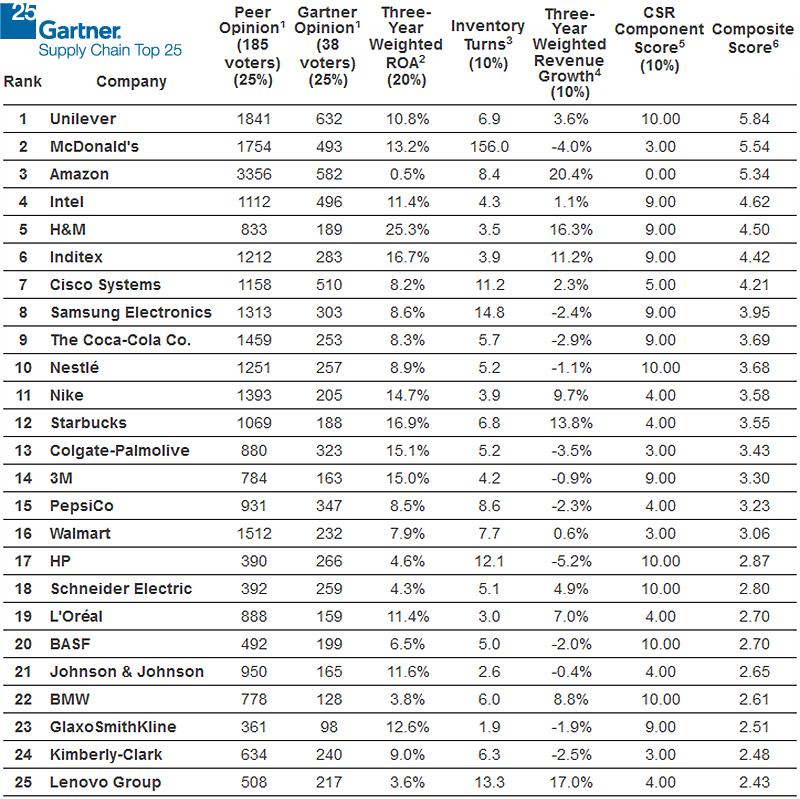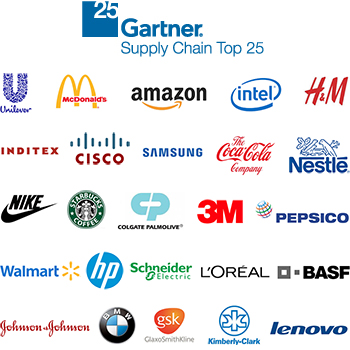Gartner Announces Its Rankings of the 2016 Supply Chain Top 25

Gartner, Inc. has released the findings from its annual Supply Chain Top 25, identifying supply chain leaders and highlighting their best practices.
Analysts announced the findings at the Gartner Supply Chain Executive Conference, which was held at the JW Marriott Desert Ridge Resort and Spa in Phoenix, AZ.
“2016 marks the 12th year of our annual Supply Chain Top 25 ranking,” said Stan Aronow, research vice president at Gartner.
“In this year’s edition, there are several longtime leaders with new lessons to share and a number of more recent entrants from the high-tech, industrial, chemical, auto and life sciences sectors.”
For the first time, Unilever topped the ranking, followed by McDonald’s, Amazon, Intel and a newcomer to the top five, H&M (see Table 1).
Five new companies made the Supply Chain Top 25 this year with Schneider Electric, BASF and BMW joining the list for the first time, and HP and GlaxoSmithKline rejoining after several years.
Apple and P&G continued to qualify for the Masters category, which Gartner introduced in 2015 to recognize sustained supply chain leadership over the last 10 years.
While this category is separate from the overall Supply Chain Top 25 list, these companies continue to be evaluated as part of Gartner’s annual research study.
Apple continues to succeed by offering platforms that ecosystems of partners build on to meet customers’ needs.
The big forward-facing question for Apple and its supply chain is whether it can deliver on the next big innovations to continue the revenue and earnings pace of the last decade.
For the majority of its products, P&G is running an end-to-end synchronization program. Every part of the supply chain operates based on the daily cadence of consumption, in some cases triggered by demand at the shelf.
The supply chain team brings data and analysis skills to the process with the ultimate goal of increasing the value that each active SKU contributes to the company.
Along with the Masters category, the Supply Chain Top 25 continues to offer a platform for insights, learning, debate and contribution to the rising influence of supply chain practices on the global economy.
Table 1. The Gartner Supply Chain Top 25 for 2016

Notes:
- Gartner Opinion and Peer Opinion: Based on each panel’s forced-rank ordering against the definition of “DDVN orchestrator.”
- ROA: ((2015 net income/2015 total assets) * 50%) + ((2014 net income/2014 total assets) * 30%) + ((2013 net income/2013 total assets) * 20%).
- Inventory Turns: 2015 cost of goods sold/2015 quarterly average inventory.
- Revenue Growth: ((change in revenue 2015-2014) * 50%) + ((change in revenue 2014-2013) * 30%) + ((change in revenue 2013-2012) * 20%).
- CSR Component Score: Index of third-party corporate social responsibility measures of commitment, transparency and performance.
- Composite Score: (Peer Opinion * 25%) + (Gartner Research Opinion *25%) + (ROA * 20%) + (Inventory Turns * 10%) + (Revenue Growth * 10%) + (CSR Component Score * 10%).
2015 data used where available. Where unavailable, latest available full-year data used. All raw data normalized to a 10-point scale prior to composite calculation. “Ranks” for tied composite scores are determined using next decimal point comparison.
Source: Gartner (May 2016)
In recognition of the fact that running an ethical and sustainable supply chain is a key aspect of leadership, Gartner has added a quantitative measure of corporate social responsibility (CSR) to the Supply Chain Top 25 methodology. CSR is one of three standout trends highlighted for supply chain leaders in 2016.
Customer-Driven Partner Integration
Gartner’s supply chain research is centered on the concept of running a demand-driven value network (DDVN). While customer-centricity is a natural extension and enabler of DDVN, in the past year, some companies and ecosystems have raised the bar in terms of what this means. More broadly, digital business has emerged as a key enabler of tighter integration across value chains.
“Leading companies in the process and industrial discrete manufacturing industries, for example, are not only getting better visibility to their own manufacturing and outbound transportation networks, but integrating that visibility with similar data from upstream partners,” said Mr. Aronow. “This provides a holistic view of supply to their customers and the ability to sense and respond to potential disrupters earlier than they have in the past.”
Adoption of Advanced Analytics
Another trend at leading supply chains is the use of advanced analytics to aid in running multiple parts of their operations, spanning the entire end-to-end supply chain. Some consumer products companies have enabled permission-based auto-replenishment of their products based on signals from internet-connected smart sensors embedded in the products at consumers’ homes. The usage data captured as part of this process is used to generate better demand forecasts based on usage personas and to inform the design of new products entering the pipeline. In each case, the value for these companies is in the algorithms that convert disparate data points into operational insights.
Increasing Emphasis on Corporate Social Responsibility
Running socially responsible supply chains aligns with what investors, customers, employees and the general public expect from companies today. “Mainstream institutional investors are paying greater attention to a company’s nonfinancial performance indicators, including its handling of environmental, social and governance (ESG) factors,” said Mr. Aronow. “Supply chain executives should expect their organizations to become a bigger part of their company’s investor relations story as these stakeholders expand their awareness of ESG issues.”
More detailed analysis is available in the Special Report “The Gartner Supply Chain Top 25 for 2016.”
Related: Is Apple’s Supply Chain Really the No. 1? A Case Study

Article Topics
Gartner News & Resources
Gartner foresees sizeable uptake for next-gen humanoid robots Risk Management: Building resilient supply chains in a risky world Ranking the Top 10 Schools to Learn About Supply Chains Gartner Unveils Top Trends in Supply Chain Technology Major Shift Underway in Logistics KPI Reporting E-commerce Logistics: An endless array of challenges Supply Chain Management (SCM) applications keep the supply chain humming More GartnerLatest in Supply Chain
TIm Cook Says Apple Plans to Increase Investments in Vietnam Amazon Logistics’ Growth Shakes Up Shipping Industry in 2023 Spotlight Startup: Cart.com is Reimagining Logistics Walmart and Swisslog Expand Partnership with New Texas Facility Nissan Channels Tesla With Its Latest Manufacturing Process Taking Stock of Today’s Robotics Market and What the Future Holds U.S. Manufacturing Gains Momentum After Another Strong Month More Supply Chain














